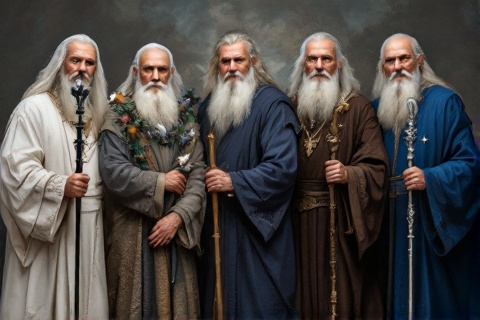
Unveiling the Istari: Wizards of Middle-earth
The Mysterious Order That Shaped the Fate of Tolkien's World
Origins in Valinor

The Istari, known commonly as Wizards in Middle-earth,
were powerful Maiar spirits chosen by the Valar
from among their own servants in Valinor. These divine beings
were selected from the noble race of the Maiar, the same order of spirits as
Sauron himself, though they remained faithful to the Valar
and their mission of preserving the light of the West.
In the year 1000 of the Third Age, the Valar grew deeply
concerned about Sauron's increasing influence in Middle-earth. The Dark Lord had
begun to stir again in the fortress of Dol Guldur, though his true identity
remained concealed for many years. The Valar, guided by Manwë's wisdom, decided
to send emissaries who could unite and counsel the free peoples in their
inevitable struggle against the shadow.
Each of the Istari was carefully chosen for their unique qualities and strengths
that would serve their mission. Curumo possessed unmatched knowledge and craft,
Olórin demonstrated the greatest wisdom and understanding
of all creatures great and small, while others showed particular affinity with
nature or diplomatic skills that would prove valuable in their tasks.
Upon their arrival in Middle-earth, these Maiar spirits took the forms of
elderly men, clad in robes of different colors denoting their order
and role. This deliberate choice of appearance was made to ensure they would be
accepted as counselors rather than gods or kings, allowing them to move freely
among elves, men, and other races while earning trust through
wisdom rather than inspiring fear through displays of power.
The Five Who Came to Middle-earth

Curumo, who became known as Saruman in Middle-earth, was appointed as the head
of the White Council and leader of the Istari order. His deep knowledge of the
craft of rings and the lore of Sauron's devices made
him an invaluable asset in the fight against the Dark Lord. Saruman established
himself in the tower of Orthanc at Isengard, where he gathered extensive
knowledge and developed his considerable powers of persuasion and diplomacy.
Olórin, called Gandalf by most in Middle-earth, was considered the wisest of all
the Maiar, though he himself did not know it. Before his mission, he walked
unseen among the elves of Valinor, learning compassion and understanding from
his teacher Nienna. Though he was actually the most powerful of the Istari, he
remained humble and preferred simple gray robes, earning him the title Gandalf
the Grey.
Aiwendil, taking the name Radagast, was chosen specifically by Yavanna for his
exceptional understanding of birds and beasts. He made his home at Rhosgobel
near the borders of Mirkwood, where he developed deep
connections with the creatures of Middle-earth. His knowledge of nature and its
inhabitants proved valuable in gathering intelligence about enemy movements
through his networks of bird and animal friends.
The Blue Wizards, Alatar and Pallando, also called the Ithryn Luin, came to
Middle-earth together and were selected for their particular skills in
understanding the cultures and peoples of distant lands. They wore robes of
sea-blue and were sent with the specific purpose of traveling into the far
eastern regions of Middle-earth, where Sauron's influence was growing among the
various peoples there.
Powers and Limitations
The Valar placed specific restrictions on the Istari's use of power in
Middle-earth. They were expressly forbidden from confronting Sauron's might
directly with their own inherent strength, as this would risk devastating
consequences for the lands and peoples they were meant to protect. This
limitation reflected the Valar's wisdom in learning from the catastrophic
battles of earlier ages.
The primary mission of the Istari was to provide counsel and inspiration to the
free peoples of Middle-earth, helping them find the strength within themselves
to resist evil. They were instructed to guide rather than rule, to kindle hearts
rather than dominate minds, and to support rather than lead. This approach
required great patience and subtlety, working through influence and inspiration
rather than direct action.
While inhabiting their physical forms, the Istari retained access to their
magical abilities, though in a more limited capacity than their true Maiar
nature would allow. They could still perform great works of power, as
demonstrated by Gandalf's confrontation with the Balrog or Saruman's control
over the weather at Caradhras, but these abilities were constrained by their
embodied forms.
The physical bodies the Istari inhabited were genuinely mortal and could
experience hunger, fatigue, and even death. If slain, their spirits would return
to Valinor, though they could potentially be sent back if the Valar deemed it
necessary, as occurred with Gandalf after his fall in
Moria. This mortality served as both a limitation and a way
to help them better understand and empathize with those they were sent to aid.
Saruman the White

Saruman's position as the head of the White Council and leader of the Istari
order was based on his superior knowledge and understanding of the ways of the
Enemy. Among all the Istari, he possessed the deepest comprehension of ring-lore
and the arts that Sauron employed, making him initially the most qualified to
oppose the Dark Lord's schemes.
As a master of craft and technology, Saruman developed increasingly
sophisticated methods to enhance his power and influence. His voice became his
most potent weapon, capable of swaying even the wisest with its persuasive
melody. He transformed Isengard into an industrial fortress, breeding new
strains of orcs and developing weapons of war that combined magic
with machinery.
The corruption of Saruman stemmed from his pride and his intense study of the
Enemy's ways. Through his palantír, he began to believe that Sauron's victory
was inevitable, and his desire to possess the One Ring
grew until it consumed him. His rationalization that he could use the Ring to
overthrow Sauron and establish a better order proved to be his ultimate undoing.
Saruman's fall from grace culminated in his defeat at the Battle of Helm's Deep
and the destruction of his power at Isengard by the Ents. His fate served as a
powerful illustration of how even the wisest could be corrupted by pride and the
desire for power, ending with his death at the hands of his own servant
Gríma in the Shire, far from his former glory.
Gandalf the Grey and White

Gandalf's approach to his mission in Middle-earth was characterized by his deep
wisdom and genuine love for its inhabitants. Unlike Saruman, who sought to
dominate and control, Gandalf worked to understand and inspire the free peoples.
His humility and willingness to work with all races, from the greatest of elven
lords to the simplest of hobbits, demonstrated his true wisdom.
The Grey Wizard's method of fulfilling his mission focused on encouraging and
advising rather than commanding. He became known throughout Middle-earth as a
wanderer, carrying news and counsel to all who would listen. His strategy
involved identifying and nurturing the inherent strength and courage within
others, particularly exemplified in his trust in hobbits and their resilience.
Following his battle with the Balrog of Moria, Gandalf's spirit briefly left
Middle-earth before being sent back by Eru Ilúvatar himself. He returned as
Gandalf the White, embodying greater power and purpose than before, taking up
the role of chief of the Istari after Saruman's fall. This transformation
represented a divine acknowledgment of his faithful service and the continuing
need for his presence in Middle-earth.
Throughout the War of the Ring, Gandalf proved to be the most successful of the
Istari in fulfilling their intended purpose. He remained true to the mission of
uniting and inspiring the free peoples against Sauron, never seeking power for
himself but always working to strengthen others. His role in orchestrating the
final defeat of Sauron demonstrated the effectiveness of the Valar's original
strategy of subtle guidance over direct confrontation.
Radagast the Brown

Radagast the Brown was specifically chosen by Yavanna, the Vala responsible for
all growing things in Arda, due to his special affinity for the natural world.
His selection reflected the Valar's understanding that the struggle against
Sauron would require attention to all aspects of Middle-earth, including its
flora and fauna.
After establishing himself at Rhosgobel, Radagast became deeply immersed in the
lives and languages of birds and beasts. His involvement with the natural world
grew so profound that he developed extraordinary abilities to communicate with
and understand animals, making him an unparalleled expert in the ways of
Middle-earth's creatures.
Despite criticism from some that he had strayed from his primary mission,
Radagast maintained an important vigil in Mirkwood during the darkening years.
His presence helped prevent the forest from falling completely under the shadow
of Dol Guldur, and his networks of bird and animal allies provided valuable
intelligence to the White Council.
While many considered Radagast to have failed in his mission by becoming too
focused on animals rather than the free peoples, his work proved valuable in
unexpected ways. His assistance to Gandalf, particularly in providing crucial
information and aid through his bird messengers, demonstrated that his
connection to nature served the greater good in the struggle against evil.
The Mysterious Blue Wizards

Alatar and Pallando, the Blue Wizards, embarked on a long journey into the vast
eastern regions of Middle-earth shortly after their arrival. Their mission
focused on the peoples of Rhûn and Harad, where Sauron's influence had grown
strong during the Second Age and continued to pose a
significant threat.
The fate of the Blue Wizards remained one of the great mysteries of the Third
Age, as they never returned to the western lands. The lack of communication or
news from these regions led many in Gondor and other western
realms to wonder whether they had failed in their mission or perhaps even fallen
under Sauron's influence.
In his later writings, Tolkien suggested that the Blue Wizards' work in the East
was more successful than initially believed. They likely worked to establish
resistance movements and secret cults opposed to Sauron's dominion, weakening
his hold over the eastern peoples and preventing him from gathering even greater
forces against the West.
The influence of the Blue Wizards played a crucial role in limiting Sauron's
ability to dominate all the eastern lands. Their efforts helped ensure that many
eastern peoples either remained neutral in the War of the Ring or provided less
support to Sauron than they might have otherwise, thereby preventing the Dark
Lord from overwhelming the western lands with sheer numbers.
Legacy and Impact

The Istari's impact on the defeat of Sauron cannot be overstated, though their
influence often worked in subtle and unexpected ways. Through their guidance and
counsel, they helped establish and maintain the alliances and strategies that
eventually led to the Dark Lord's downfall, particularly through Gandalf's role
in the War of the Ring.
Throughout the Third Age, the Istari's presence shaped many of the most
significant events in Middle-earth's history. From the formation of the White
Council to the discovery of the One Ring's location, from the liberation of
Rohan to the return of the King to Gondor,
their influence can be traced through all the major developments that led to
Sauron's ultimate defeat.
The varied successes and failures of the Istari demonstrated the complexity of
their mission and the challenges they faced. While Saruman's fall represented a
significant setback, Gandalf's triumph and the possibly successful work of the
Blue Wizards in the East showed that their mission, though difficult, was not in
vain.
After the destruction of the One Ring and Sauron's final defeat, the remaining
Istari's mission in Middle-earth was complete. Gandalf, last of the order to
remain true to his purpose, departed over the sea with the bearers of the Elven
Rings, while the fate of Radagast and the Blue Wizards remained part of the
unfinished tales of Middle-earth.
